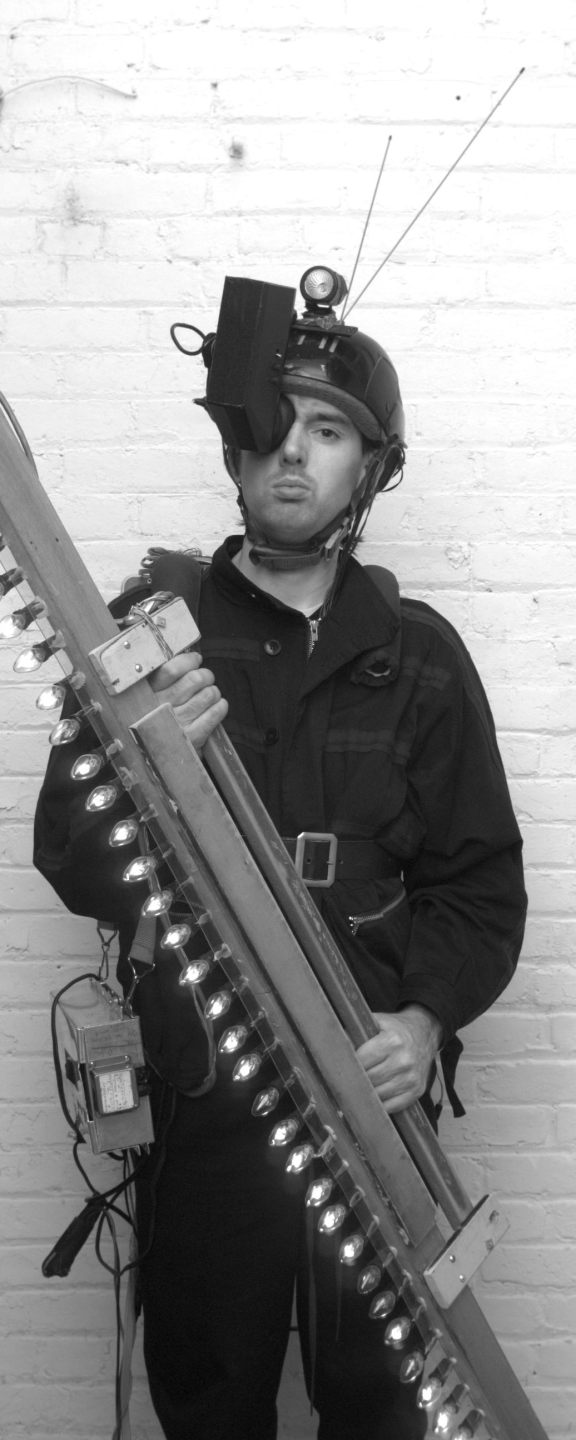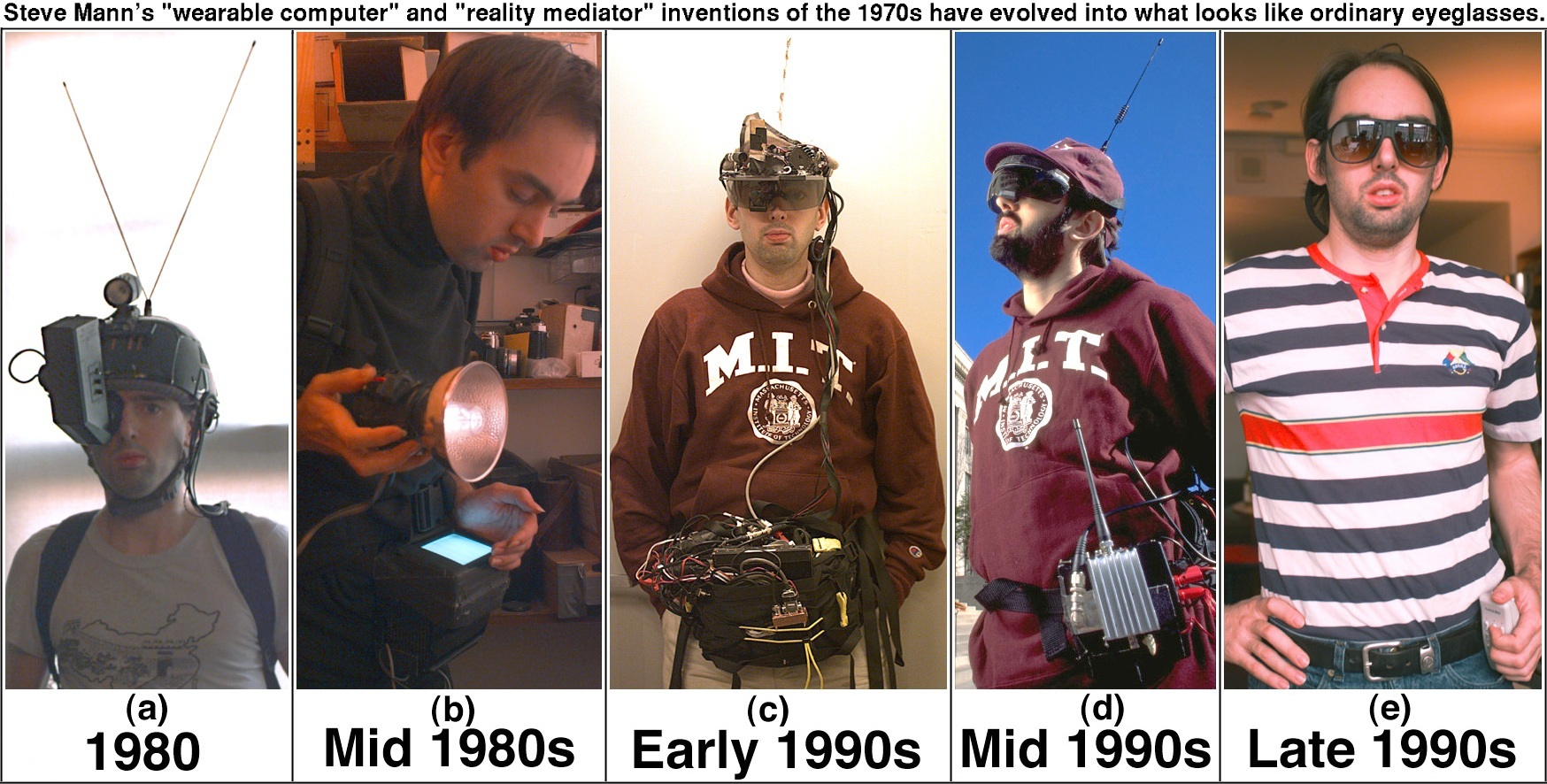Difference between revisions of "Steve Mann"
Caseorganic (Talk | contribs) |
Caseorganic (Talk | contribs) |
||
| Line 1: | Line 1: | ||
| − | + | '''Steve Mann''' (born 1962, Hamilton, Ontario, Canada) | |
| − | Steve Mann | + | |
| − | + | [[image:lightspace-wearcomp-lightcomb-steve-mann.jpg|right|200px]] | |
| − | [[image:lightspace-wearcomp-lightcomb-steve-mann.jpg|right| | + | |
| − | + | Dr. Steve Mann, Canadian technologist and teacher, is a living laboratory for the cyborg life-style. He is one of the leaders in WearComp (wearable computing) and helped found the Wearable Computers group at the MIT Media Lab. | |
| − | + | ||
| − | + | Dr. Mann believes computers should be designed to function in ways organic to human needs rather than requiring humans to adapt to demanding requirements of technology. Mann has developed computer systems — both wearable and embedded — to augment biological systems and capabilities during all waking hours. His work touches a wide range of disciplines from implant technology to sousveillance, privacy, cyber security and cyborg-law. | |
| + | |||
| + | <blockquote>“…a living laboratory | ||
| + | for cyborg lifestyles.” </blockquote> | ||
| − | + | Mann first experimented with wearable computing in high school in the 70s. At MIT he literally bristled with equipment, wearing 80 pounds of computing equipment to class. Moore’s Law, however, has continuously reduced the form factor. In 1994 Mann introduced a Wearable Wireless Webcam that transmitted images for “cyber-logging” on a webpage in near real-time. Later his EyeTap camera worn over one eye provided wearers with computer-mediated visions of reality. Recent versions are virtually invisible on frames of glasses. | |
| − | + | Dr. Mann has written that “unlike other computers (including laptops and PDAs), a WearComp is inextricably intertwined with its wearer - WearComp's ‘always ready’ characteristic leads to a new form of synergy between human and computer". Mann sees this as relying on three operational modalities. | |
| − | + | The first is constancy, which is about technology designed to be available at any time or place. Signals run from computer to human and human to computer constantly. | |
| − | + | The second is augmentation, which defines the technology as serving to augment human activities. In other words, computers are not seen as primary, but as always being in service to human sensing, needs and priorities. | |
| − | + | The third is mediation, which is about encapsulating the human user with a protective solitude and privacy. The technology can filter or block information coming in (solitude.) Or it can filter or block information from leaking out (privacy.) | |
| − | + | ||
| − | |||
| − | + | [[image:steve-mann-evolution-of-wearable.jpg|left|500px]] | |
| − | + | Dr. Steve Mann is author of more than 200 publications. His 2001 book Cyborg: Digital Destiny and Human Possibility in the Age of the Wearable Computer provides a popular culture view of day-to-day cyborg life. CYBERMAN, a feature film about his life and work, was released the same year. Dr. Mann’s research and activities are visible online at http://wearcam.org and http://eyetap.org. Mann received a PhD in Media Arts and Sciences from MIT in 1997. | |
| − | |||
| − | + | (url recommendations go here) | |
| − | + | ||
| − | + | ||
| + | ==References== | ||
| + | <references /> | ||
[[Category:People]] | [[Category:People]] | ||
[[Category:Book Pages]] | [[Category:Book Pages]] | ||
| − | [[Category: | + | [[Category:Finished]] |
__NOTOC__ | __NOTOC__ | ||
Revision as of 00:32, 9 April 2012
Steve Mann (born 1962, Hamilton, Ontario, Canada)
Dr. Steve Mann, Canadian technologist and teacher, is a living laboratory for the cyborg life-style. He is one of the leaders in WearComp (wearable computing) and helped found the Wearable Computers group at the MIT Media Lab.
Dr. Mann believes computers should be designed to function in ways organic to human needs rather than requiring humans to adapt to demanding requirements of technology. Mann has developed computer systems — both wearable and embedded — to augment biological systems and capabilities during all waking hours. His work touches a wide range of disciplines from implant technology to sousveillance, privacy, cyber security and cyborg-law.
“…a living laboratory for cyborg lifestyles.”
Mann first experimented with wearable computing in high school in the 70s. At MIT he literally bristled with equipment, wearing 80 pounds of computing equipment to class. Moore’s Law, however, has continuously reduced the form factor. In 1994 Mann introduced a Wearable Wireless Webcam that transmitted images for “cyber-logging” on a webpage in near real-time. Later his EyeTap camera worn over one eye provided wearers with computer-mediated visions of reality. Recent versions are virtually invisible on frames of glasses.
Dr. Mann has written that “unlike other computers (including laptops and PDAs), a WearComp is inextricably intertwined with its wearer - WearComp's ‘always ready’ characteristic leads to a new form of synergy between human and computer". Mann sees this as relying on three operational modalities.
The first is constancy, which is about technology designed to be available at any time or place. Signals run from computer to human and human to computer constantly.
The second is augmentation, which defines the technology as serving to augment human activities. In other words, computers are not seen as primary, but as always being in service to human sensing, needs and priorities.
The third is mediation, which is about encapsulating the human user with a protective solitude and privacy. The technology can filter or block information coming in (solitude.) Or it can filter or block information from leaking out (privacy.)
Dr. Steve Mann is author of more than 200 publications. His 2001 book Cyborg: Digital Destiny and Human Possibility in the Age of the Wearable Computer provides a popular culture view of day-to-day cyborg life. CYBERMAN, a feature film about his life and work, was released the same year. Dr. Mann’s research and activities are visible online at http://wearcam.org and http://eyetap.org. Mann received a PhD in Media Arts and Sciences from MIT in 1997.
(url recommendations go here)

